Colony-stimulating factors for chemotherapy-induced febrile neutropenia
- PMID: 25356786
- PMCID: PMC7141179
- DOI: 10.1002/14651858.CD003039.pub2
Colony-stimulating factors for chemotherapy-induced febrile neutropenia
Abstract
Background: Febrile neutropenia is a frequent adverse event experienced by people with cancer who are undergoing chemotherapy, and is a potentially life-threatening situation. The current treatment is supportive care plus antibiotics. Colony-stimulating factors (CSFs), such as granulocyte-CSF (G-CSF) and granulocyte-macrophage CSF (GM-CSF), are cytokines that stimulate and accelerate the production of one or more cell lines in the bone marrow. Clinical trials have addressed the question of whether the addition of a CSF to antibiotics could improve outcomes in individuals diagnosed with febrile neutropenia. However, the results of these trials are conflicting.
Objectives: To evaluate the safety and efficacy of adding G-CSF or GM-CSF to standard treatment (antibiotics) when treating chemotherapy-induced febrile neutropenia in individuals diagnosed with cancer.
Search methods: We conducted the search in March 2014 and covered the major electronic databases: the Cochrane Central Register of Controlled Trials (CENTRAL), MEDLINE, EMBASE, LILACS, and SCI. We contacted experts in hematology and oncology and also scanned the citations from the relevant articles.
Selection criteria: We searched for randomized controlled trials (RCTs) that compared CSF plus antibiotics versus antibiotics alone for the treatment of chemotherapy-induced febrile neutropenia in adults and children.
Data collection and analysis: We used the standard methodological procedures expected by The Cochrane Collaboration. We performed meta-analysis of the selected studies using Review Manager 5 software.
Main results: Fourteen RCTs (15 comparisons) including a total of 1553 participants addressing the role of CSF plus antibiotics in febrile neutropenia were included. Overall mortality was not improved by the use of CSF plus antibiotics versus antibiotics alone (hazard ratio (HR) 0.74 (95% confidence interval (CI) 0.47 to 1.16) P = 0.19; 13 RCTs; 1335 participants; low quality evidence). A similar finding was seen for infection-related mortality (HR 0.75 (95% CI 0.47 to 1.20) P = 0.23; 10 RCTs; 897 participants; low quality evidence). Individuals who received CSF plus antibiotics were less likely to be hospitalized for more than 10 days (risk ratio (RR) 0.65 (95% CI 0.44 to 0.95) P = 0.03; 8 RCTs; 1221 participants; low quality evidence) and had more number of participants with a more faster neutrophil recovery (RR 0.52 (95% CI 0.34 to 0.81) P = 0.004; 5 RCTs; 794 participants; moderate quality evidence) than those treated with antibiotics alone. Similarly, participants receiving CSF plus antibiotics had shorter duration of neutropenia (standardized mean difference (SMD) -1.70 (95% CI -2.65 to -0.76) P = 0.0004; 9 RCTs; 1135 participants; moderate quality evidence), faster recovery from fever (SMD -0.49 (95% CI -0.90 to -0.09) P value = 0.02; 9 RCTs; 966 participants; moderate quality evidence) and shorter duration of antibiotics use (SMD -1.50 (95% CI -2.83 to -0.18) P = 0.03; 3 RCTs; 457 participants; low quality evidence) compared with participants receiving antibiotics alone. We found no significant difference in the incidence of deep venous thromboembolism (RR 1.68 (95% CI 0.72 to 3.93) P = 0.23; 4 RCTs; 389 participants; low quality evidence) in individuals treated with CSF plus antibiotics compared with those treated with antibiotics alone. We found higher incidence of bone or joint pain or flu-like symptoms (RR 1.59 (95% CI 1.04 to 2.42) P = 0.03; 6 RCTs; 622 participants; low quality evidence) in individuals treated with CSF plus antibiotics compared with those treated with antibiotics alone. Overall, the methodological quality of studies was moderate to low across different outcomes. The main reasons to downgrade the quality of evidence were inconsistency across the included studies and imprecision of results.
Authors' conclusions: The use of a CSF plus antibiotics in individuals with chemotherapy-induced febrile neutropenia had no effect on overall mortality, but reduced the amount of time participants spent in hospital and improved their ability to achieve neutrophil recovery. It was not clear whether CSF plus antibiotics had an effect on infection-related mortality. Participants receiving CSFs had shorter duration of neutropenia, faster recovery from fever and shorter duration of antibiotics use.
Conflict of interest statement
OACC ‐ None known BD ‐ None known TEAB ‐ None known GL ‐ PI on research grant to the Fred Hutchinson Cancer Research Center, Seattle, WA, USA RM ‐ None known LMP ‐ None known
Figures
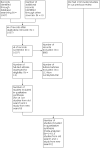



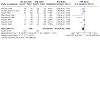
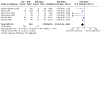

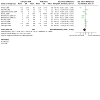
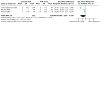

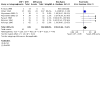


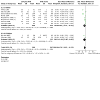

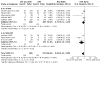

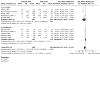


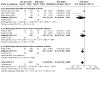




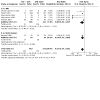

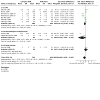
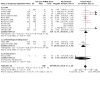
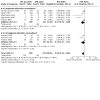

Update of
-
Colony stimulating factors for chemotherapy induced febrile neutropenia.Cochrane Database Syst Rev. 2003;(3):CD003039. doi: 10.1002/14651858.CD003039. Cochrane Database Syst Rev. 2003. Update in: Cochrane Database Syst Rev. 2014 Oct 30;(10):CD003039. doi: 10.1002/14651858.CD003039.pub2. PMID: 12917942 Updated.
References
References to studies included in this review
Anaissie 1996 {published data only}
-
- Anaissie EJ, Vartivarian S, Bodey GP, Legrand C, Kantarjian H, Abi-Said D, et al. Randomized comparison between antibiotics alone and antibiotics plus granulocyte-macrophage colony-stimulating factor (Escherichia coli-derived in cancer patients with fever and neutropenia. The American Journal of Medicine 1996;100(1):17-23. - PubMed
Arnberg 1998 {published data only}
-
- Arnberg H, Letocha H, Nou F, Westlin JF, Nilsson S. GM-CSF in chemotherapy-induced febrile neutropenia - a double-blind randomized study. Anticancer Research 1998;18(2B):1255-60. - PubMed
Aviles 1996 {published data only}
-
- Aviles A, Guzman R, Garcia EL, Talavera A, Diaz-Maqueo JC. Results of a randomized trial of granulocyte colony-stimulating factor in patients with infection and severe granulocytopenia. Anticancer Drugs 1996;7(4):392-7. - PubMed
Biesma 1990 {published data only}
-
- Biesma B, Vries EG, Willemse PH, Sluiter WJ, Postmus PE, Limburg PC, et al. Efficacy and tolerability of recombinant human granulocyte-macrophage colony-stimulating factor in patients with chemotherapy-related leukopenia and fever. European Journal of Cancer 1990;26(9):932-6. - PubMed
Garcia‐Carbonero 2001 {published data only}
-
- Garcia-Carbonero R, Mayordomo JI, Tornamira MV, Lopez-Brea M, Rueda A, Guillem V, et al. Granulocyte colony-stimulating factor in the treatment of high-risk febrile neutropenia: a multicenter randomized trial. Journal of the National Cancer Institute 2001;93(1):31-8. - PubMed
Lopez‐Hernandez 2000 {published data only}
-
- Lopez-Hernandez MA, Jimenez-Alvarado R, Borbolla-Escoboza R, Diego Flores-Chapa J, Alvarado-Ibarra M, Gonzalez-Avante M, et al. Granulocyte colony-stimulating factor in the treatment of febrile neutropenia. Gaceta Médica de México 2000;136(2):99-105. - PubMed
Maher 1994 {published data only}
-
- Maher DW, Lieschke GJ, Green M, Bishop J, Stuart-Harris R, Wolf M, et al. Filgrastim in patients with chemotherapy-induced febrile neutropenia. A double-blind, placebo-controlled trial. Annals of Internal Medicine 1994;121(7):492-501. - PubMed
Mayordomo 1995 {published data only}
-
- Mayordomo JI, Rivera F, Diaz-Puente MT, Lianes P, Colomer R, Lopez-Brea M, et al. Improving treatment of chemotherapy-induced neutropenic fever by administration of colony-stimulating factors. Journal of the National Cancer Institute 1995;87(11):803-8. - PubMed
Mitchell 1997 {published data only}
-
- Mitchell PL, Morland B, Stevens MC, Dick G, Easlea D, Meyer LC, et al. Granulocyte colony-stimulating factor in established febrile neutropenia: a randomized study of pediatric patients. Journal of Clinical Oncology 1997;15(3):1163-70. - PubMed
Ravaud 1998 {published data only}
-
- Ravaud A, Chevreau C, Cany L, Houyau P, Dohollou N, Roche H, et al. Granulocyte-macrophage colony-stimulating factor in patients with neutropenic fever is potent after low-risk but not after high-risk neutropenic chemotherapy regimens: results of a randomized phase III trial. Journal of Clinical Oncology 1998;16(9):2930-6. - PubMed
Riikonen 1994 {published data only}
-
- Riikonen P, Saarinen UM, Makipernaa A, Hovi L, Komulainen A, Pihkala J, Jalanko H. Recombinant human granulocyte-macrophage colony-stimulating factor in the treatment of febrile neutropenia: a double blind placebo-controlled study in children. Pediatric Infectious Disease Journal 1994;13(3):197-202. - PubMed
Rodriguez 2005 {published data only}
-
- Rodriguez ZN, Tordecilla CJ, Campbell BM, Joannon SP, Rizzardini LC, Soto AV, et al. Usefulness of G-CSF in pediatric high risk cancer patients with fever and neutropenia [Utilidad del factor estimulador de colonias de granulocitos (G-CSF) en episodios de neutropenia febril de alto riesgo en ninos con cancer.]. Revista Chilena de Infectologia 2005;22(3):223-7. [PMID: ] - PubMed
Vellenga 1996 {published data only}
-
- Vellenga E, Uyl-de Groot CA, Wit R, Keizer HJ, Lowenberg B, ten Haaft MA, et al. Randomized placebo-controlled trial of granulocyte-macrophage colony-stimulating factor in patients with chemotherapy-related febrile neutropenia. Journal of Clinical Oncology 1996;14(2):619-27. - PubMed
Yoshida 1999 {published data only}
-
- Yoshida M, Karasawa M, Naruse T, Fukuda M, Hirashima K, Oh H, et al. Effect of granulocyte-colony stimulating factor on empiric therapy with flomoxef sodium and tobramycin in febrile neutropenic patients with hematological malignancies. Kan-etsu Hematological Disease and Infection Study Group. International Journal of Hematology 1999;69(2):81-8. - PubMed
References to studies excluded from this review
Balcerska 1995 {published data only}
-
- Balcerska A, Ploszynska A, Polczynska K, Maciejka-Kapuscinska L, Wlazlowski M, Drozynska E, et al. The effect of cytokines G-CSF and GM-CSF in therapy of childhood malignancies [Ocena Skutecznosci Czynnikow Wzrostu G-CSF I GM-CSF W Leczeniu Wspomagajacym Choroby Nowotworowej U Dzieci]. Annales Academiae Medicae Gedanensis 1995;25:117-24.
Beveridge 1998 {published data only}
-
- Beveridge RA, Miller JA, Kales AN, Binder RA, Robert NJ, Harvey JH, et al. A comparison of efficacy of sargramostim (yeast-derived RhuGM-CSF) and filgrastim (bacteria-derived RhuG-CSF) in the therapeutic setting of chemotherapy-induced myelosuppression. Cancer Investigation 1998;16(6):366-73. - PubMed
Bodey 1994 {published data only}
-
- Bodey GP, Anaissie E, Gutterman J, Vadhan-Raj S. Role of granulocyte-macrophage colony-stimulating factor as adjuvant treatment in neutropenic patients with bacterial and fungal infection. European Journal of Clinical Microbiology & Infectious Diseases 1994;13 Suppl 2:S18-22. - PubMed
Feng 1998 {published data only}
-
- Feng F, Zhou L. Randomized controlled study of leucomax (recombinant human granulocyte-macrophage colony stimulating factor, rhGM-CSF) in the treatment of cancer chemotherapy-induced leucopenia. Zhonghua Zhong Liu Za Zhi [Chinese Journal of Oncology] 1998;20(6):451-3. - PubMed
Fengyi 1998 {published data only}
-
- Fengyi F, Liqiang Z. Randomized controlled study of leucomax (recombinant human granulocyte- macrophage colony stimulating factor, rhGM-CSF) in the treatment of cancer chemotherapy-induced leucopenia. Zhonghua Zhong Liu Za Zhi [Chinese Journal of Oncology] 1998;20(6):451-3. - PubMed
Garcia‐Carb 1999a {published data only}
-
- Garcia-Carbonero R, Mayordomo JI, Tornamira MV, Lopez-Brea M, Rueda A, Guillem V, et al. Filgrastim in the treatment of high-risk febrile neutropenia: results of a multicenter randomized phase III trial. Proceedings of the Annual Meeting of the American Society of Clinical Oncology 1999;18:Abstract #2253.
Garcia‐Carb 1999b {published data only}
-
- Garcia-Carbonero R, Mayordomo JI, Tornamira MV, Lopez-Brea M, Rueda A, Guillem V, et al. Randomized comparison of broad spectrum antibiotics with or without filgrastim in the treatment of patients with high-risk fever and grade IV neutropenia. European Journal of Cancer 1999;35(Supplement 4):360.
Gebbia 1994 {published data only}
-
- Gebbia V, Valenza R, Testa A, Cannata G, Borsellino N, Gebbia N. A prospective randomized trial of thymopentin versus granulocyte--colony stimulating factor with or without thymopentin in the prevention of febrile episodes in cancer patients undergoing highly cytotoxic chemotherapy. Anticancer Research 1994;14(2B):731-4. - PubMed
Gunay 1998 {published data only}
-
- Gunay U, Tanritanir A, Meral A, Sevinir BB, Hacimollaoglu MK. The effects of granulocyte colony-stimulating factor (G-CSF) and intravenous immunoglobulin (IVIG) on the treatment of neutropenic fever in children.. Cocuk Sagligi Ve Hastaliklari Dergisi 1998;41(4):433-44.
Herrmann 1990 {published data only}
-
- Herrmann F, Schulz G, Wieser M, Kolbe K, Nicolay U, Noack M, et al. Effect of granulocyte-macrophage colony-stimulating factor on neutropenia and related morbidity induced by myelotoxic chemotherapy. The American Journal of Medicine 1990;88(6):619-24. - PubMed
Kaku 1993 {published data only}
-
- Kaku K, Takahashi M, Moriyama Y, Nakahata T, Masaoka T, Yoshida Y, et al. Recombinant human granulocyte-macrophage colony-stimulating factor (rhGM-CSF) after chemotherapy in patients with non-Hodgkin's lymphoma; a placebo-controlled double blind phase III trial. Leukemia and Lymphoma 1993;11(3-4):229-38. - PubMed
Kawa 1999 {published data only}
-
- Kawa K, Keiko Y, Dong PY, Sako M, Tanaka H, Hara J, et al. A multi-institutional study of optimal use of recombinant granulocyte colony stimulating factor (lenograstim) in pediatric malignancies - III. Biotherapy 1999;13(4):361-7.
Kotake 1999 {published data only}
-
- Kotake T, Usami M, Miki T, Togashi M, Akaza H, Kubota Y, et al. Effect of recombinant human granulocyte colony stimulating factor (lenograstim) on chemotherapy induced neutropenia in patients with urothelial cancer. International Journal of Urology 1999;6(2):61-7. - PubMed
Mayordomo 1992 {published data only}
-
- Mayordomo JI, Rivera F, Diaz-Puente MT, Lianes MP, Lopez-Brea M, López E. Progress report of a randomized trial on the value of adding G-CSF or GM-CSF to standard antibiotic therapy in the treatment of febrile neutropenia. Annals of Oncology 1992;3(Supplement 5: Growth factors / Oncogenes / Tumour suppressor):2.
Mayordomo 1993 {published data only}
-
- Mayordomo JI, Rivera F, Diaz Puente MT, Lianes MP, Lopez-Brea M, Lopez E, et al. Decreasing morbidity and cost of treating febrile neutropenia by adding G-CSF and GM-CSF to standard antibiotic therapy: results of a randomized trial. In: Proceedings of the Annual Meeting of the American Society of Clinical Oncology. Vol. 12. 1993:Abstract # 1510.
Michon 1998 {published data only}
-
- Michon JM, Hartmann O, Bouffet E, Meresse V, Coze C, Rubie H, et al. An open-label, multicentre, randomised phase 2 study of recombinant human granulocyte colony-stimulating factor (filgrastim) as an adjunct to combination chemotherapy in paediatric patients with metastatic neuroblastoma. European Journal of Cancer 1998;34(7):1063-9. - PubMed
Montalar 1998 {published data only}
-
- Montalar J, Santaballa A, Oltra A, Segura A, Aparicio A, Pastor M. Ofloxacin with or without stimulating colony-factors in the treatment of neutropenic fever. Annals of Oncology 1998;9(Supplement 4 palliative and supportive care):151 abstract #724.
Moriyama 1993 {published data only}
-
- Moriyama Y, Takahashi M, Kaku K, Yoshida Y, Masaoka T, Nakanishi S, et al. Effect of granulocyte-macrophage colony-stimulating factor on chemotherapy-induced granulocytopenia in patients with malignancies. Acta Haematologica 1993;89(2):70-5. - PubMed
Motoyoshi 1986 {published data only}
-
- Motoyoshi K, Takaku F, Maekawa T, Miura Y, Kimura K, Furusawa S, et al. Protective effect of partially purified human urinary colony-stimulating factor on granulocytopenia after antitumor chemotherapy. Experimental Hematology 1986;14(11):1069-75. - PubMed
Nakajima 1995 {published data only}
-
- Nakajima H, Ikeda Y, Hirashima K, Toyama K, Okuma M, Saito H, et al. A randomized controlled study of rG.CSF in patients with neutropenia after induction therapy for acute myelogenous leukemia. (rG.CSF Clinical Study Group). Rinsho Ketsueki [The Japanese Journal of Clinical Hematology] 1995;36(6):597-605. - PubMed
Ohno 1997 {published data only}
-
- Ohno R, Miyawaki S, Hatake K, Kuriyama K, Saito K, Kanamaru A, et al. Human urinary macrophage colony-stimulating factor reduces the incidence and duration of febrile neutropenia and shortens the period required to finish three courses of intensive consolidation therapy in acute myeloid leukemia: a double-blind controlled study. Journal of Clinical Oncology 1997;15(8):2954-65. - PubMed
Oshita 2000 {published data only}
-
- Oshita F, Yamada K, Nomura I, Tanaka G, Ikehara M, Noda K. Prophylactic administration of granulocyte colony-stimulating factor when monocytopenia appears lessens neutropenia caused by chemotherapy for lung cancer. American Journal of Clinical Oncology 2000;23(3):278-82. - PubMed
Ravaud 1995 {published data only}
-
- Ravaud A, Chevreau C, Bonichon F, Mihura J, Bui BN, Tabah I. A phase III trial of recombinant granulocyte-macrophage colony stimulating factor (GM-CSF) as corrective treatment in patients (pts) with neutropenic fever following antineoplastic chemotherapy (CT): results of an intermediate analysis. In: Proceedings of the Annual Meeting of the American Society of Clinical Oncology. 1995:Abstract A716.
Schroder 1999 {published data only}
-
- Schroder CP, Vries EG, Mulder NH, Willemse PH, Sleijfer DT, Hospers GA, et al. Prevention of febrile leucopenia after chemotherapy in high-risk breast cancer patients: no significant difference between granulocyte-colony stimulating growth factor or ciprofloxacin plus amphotericin B. The Journal of Antimicrobial Chemotherapy 1999;43(5):741-3. - PubMed
Soda 1996 {published data only}
-
- Soda H, Oka M, Fukuda M, Kinoshita A, Sakamoto A, Araki J, et al. Optimal schedule for administering granulocyte colony-stimulating factor in chemotherapy-induced neutropenia in non-small-cell lung cancer. Cancer Chemotherapy and Pharmacology 1996;38(1):9-12. - PubMed
Timmer‐Bonte 2005 {published data only}
-
- Timmer-Bonte JN, Boo TM, Smit HJ, Biesma B, Wilschut FA, Cheragwandi SA, et al. Prevention of chemotherapy-induced febrile neutropenia by prophylactic antibiotics plus or minus granulocyte colony-stimulating factor in small-cell lung cancer: a Dutch randomized phase III study. Journal of Clinical Oncology 2005;23(31):7974-84. [PMID: ] - PubMed
Torrecillas 1998 {published data only}
-
- Torrecillas L, Cervantes G, Zamora R, Acosta A, Cepeda F, Cortés P, et al. GM-CSF discontinuation safe level for patients with chemotherapy induced febrile or afebrile neutropenia. In: Proceedings of the Annual Meeting of the American Society of Clinical Oncology. 1998:Abstract #304.
Uyl‐de Groot 1997 {published data only}
-
- Uyl-de Groot CA, Vellenga E, Vries EG, Lowenberg B, Stoter GJ, Rutten FF. Treatment costs and quality of life with granulocyte-macrophage colony-stimulating factor in patients with antineoplastic therapy-related febrile neutropenia. Results of a randomised placebo-controlled trial. Pharmacoeconomics 1997;12(3):351-60. - PubMed
van Pelt 1997 {published data only}
-
- Pelt LJ, Craen AJ, Langeveld NE, Weening RS. Granulocyte-macrophage colony-stimulating factor (GM-CSF) ameliorates chemotherapy-induced neutropenia in children with solid tumors. Pediatric Hematology and Oncology 1997;14(6):539-45. - PubMed
Vellenga 1996b {published data only}
-
- Vellenga E, Uyl-De Groot C, Stoter G, Lowenberg B, De Vries E. Faster recovery of leukocytes due to haemopoietic growth factor in patients with chemotherapy-related granulocytopenia and fever, but no shortened hospital stay. Nederlands Tijdschrift voor Geneeskunde 1996;140(32):1650-5.
Yalcin 1996 {published data only}
-
- Yalcin S, Guler N, Kansu E, Ertenli I, Gullu I, Barista I, et al. Granulocyte-colony stimulating factor (G-CSF) administration for chemotherapy-induced neutropenia. Hematology 1996;1(2):155-61. - PubMed
Yamazaki 1989 {published data only}
-
- Yamazaki K, Kumamoto Y, Tsukamoto T, Hirose T. Prophylaxis of fever during leukocytopenia by anticancer chemotherapy. Chemotherapy 1989;37(6):838-47.
Additional references
Berghmans 2002
-
- Berghmans T, Paesmans M, Lafitte JJ, Mascaux C, Meert AP, Jacquy C, et al. Therapeutic use of granulocyte and granulocyte-macrophage colony-stimulating factors in febrile neutropenic cancer patients. A systematic review of the literature with meta-analysis. Supportive Care in Cancer 2002;10(3):181-8. [MEDLINE: ] - PubMed
Castro 1999
-
- Castro AA, Clark OA, Atallah AN. Optimal search strategy for clinical trials in the Latin American and Caribbean Health Science Literature database (LILACS database): update. Sao Paulo Medical Journal 1999;117(3):138-9. - PubMed
de Naurois 2010
-
- Naurois J, Novitzky-Basso I, Gill MJ, Marti FM, Cullen MH, Roila F, et al. Management of febrile neutropenia: ESMO Clinical Practice Guidelines. Annals of Oncology 2010;21 Suppl 5:v252-v6. - PubMed
Dickersin 1994
Egger 1997
Egger 2001
-
- Egger M, Smith GD, Altman D. Systematic Reviews in Health Care. 2nd edition. London: BMJ Books, 2001.
Freyer 1998
-
- Freyer G, Ligneau B, Trillet-Lenoir V. Colony-stimulating factors in the prevention of solid tumors induced by chemotherapy in patients with febrile neutropenia. International Journal of Antimicrobial Agents 1998;10(1):3-9. - PubMed
Giamerellou 2001
-
- Giamarellou H, Antoniadou A. Infectious complications of febrile leukopenia. Infectious Disease Clinics of North America 2001;15(2):457-82. - PubMed
GRADEpro [Computer program]
-
- GRADEpro. Version 3.2 for Windows. Jan Brozek, Andrew Oxman, Holger Schünemann, 2008.
Griffin 2001
-
- Griffin JD. Hematopoietic growth factors. In: DeVitaJr VT, Hellman S, Rosenberg SA, editors(s). Cancer: Principles and Practice of Oncology. 6th edition. Philadelphia, PA: Lippincott Williams & Wilkins, 2001.
Guyatt 2011
-
- Guyatt GH, Oxman AD, Kunz R, Woodcock J, Brozek J, Helfand M, et al. GRADE guidelines: 7. Rating the quality of evidence - inconsistency. Journal of Clinical Epidemiology 2011;64(12):1294-302. [PMID: ] - PubMed
Guyatt 2011a
-
- Guyatt GH, Oxman AD, Kunz R, Woodcock J, Brozek J, Helfand M, et al. GRADE guidelines: 8. Rating the quality of evidence - indirectness. Journal of Clinical Epidemiology 2011;64(12):1303-10. [PMID: ] - PubMed
Guyatt 2011b
-
- Guyatt G, Oxman AD, Kunz R, Brozek J, Alonso-Coello P, Rind D, et al. GRADE guidelines: 6. Rating the quality of evidence - imprecision. Journal of Clinical Epidemiology 2011;64(12):1283-93. [PMID: ] - PubMed
Guyatt 2011c
-
- Guyatt GH, Oxman AD, Montori V, Vist G, Kunz R, Brozek J, et al. GRADE guidelines: 5. Rating the quality of evidence - publication bias. Journal of Clinical Epidemiology 2011;64(12):1277-82. [PMID: ] - PubMed
Guyatt 2011d
-
- Guyatt GH, Oxman AD, Vist G, Kunz R, Brozek J, Alonso-Coello P, et al. GRADE guidelines: 4. Rating the quality of evidence - risk of bias. Journal of Clinical Epidemiology 2011;64(4):407-15. [PMID: ] - PubMed
Guyatt 2011e
-
- Guyatt G, Oxman AD, Akl E, Kunz R, Vist G, Brozek J, et al. GRADE guidelines: 1. Introduction-GRADE evidence profiles and summary of findings tables. Journal of Clinical Epidemiology 2011;64(4):383-94. [PMID: ] - PubMed
Higgins 2011a
-
- Higgins JPT, Green S (editors). Cochrane Handbook for Systematic Reviews of Interventions Version 5.1.0 [updated March 2011]. The Cochrane Collaboration, 2011.. Available from www.cochrane-handbook.org.
Higgins 2011b
-
- Higgins JPT, Deeks JJ. Chapter 7: Selecting studies and collecting data. In: Higgins JPT, Green S (editors). Cochrane Handbook for Systematic Reviews of Interventions Version 5.1.0 [updated March 2011]. The Cochrane Collaboration, 2011. Available from www.cochrane-handbook.org.
Higgins 2011c
-
- Higgins JPT, Altman DG, Sterne JAC. Chapter 8: Assessing risk of bias in included studies. In: Higgins JPT, Green S (editors). Cochrane Handbook for Systematic Reviews of Interventions Version 5.1.0 [updated March 2011]. The Cochrane Collaboration, 2011. Available from www.cochrane-handbook.org.
Higgins 2011d
-
- Higgins JPT, Altman DG, Sterne JAC. Chapter 16.5.4: Special topics in statistics. In: Higgins JPT, Green S (editors). Cochrane Handbook for Systematic Reviews of Interventions Version 5.1.0 [updated March 2011]. The Cochrane Collaboration, 2011. Available from www.cochrane-handbook.org.
Hozo 2005
Hozo 2005a
IHS 1990
-
- Immunocompromised Host Society. The design, analysis, and reporting of clinical trials on the empirical antibiotic management of the neutropenic patient. Report of a consensus panel. The Journal of Infectious Diseases 1990;161(3):397-401. - PubMed
Lyman 2002
-
- Lyman GH, Kuderer NM, Djulbegovic B. Prophylactic granulocyte colony-stimulating factor in patients receiving dose-intensive cancer chemotherapy: a meta-analysis. The American Journal of Medicine 2002;112(5):406-11. - PubMed
Mhaskar 2012
Moher 2009
-
- Moher D, Liberati A, Tetzlaff J, Altman DG. Preferred reporting items for systematic reviews and meta-analyses: the PRISMA statement. Journal of Clinical Epidemiology 2009;62(10):1006-12. - PubMed
Paesmans 1998
-
- Paesmans M. Statistical considerations in clinical trials testing empiric antibiotic regimens in patients with febrile neutropenia. Supportive Care in Cancer 1998;6(5):438-43. - PubMed
Petros 2001
-
- Petros WP. Colony-stimulating factors. In: Chabner BA, Longo DL, editors(s). Cancer Chemotherapy and Biotherapy - Principles and Practice. 5th edition. Lippincott Williams & Wilkins, 2001.
Pizzo 1999
-
- Pizzo PA. Fever in immunocompromised patients. The New England Journal of Medicine 1999;341(12):893-900. - PubMed
Review Manager 5.3
-
- Review Manager (RevMan) [Computer program]. Version 5.3. Copenhagen: The Nordic Cochrane Centre, The Cochrane Collaboration 2014.
Rubenstein 2000
-
- Rubenstein EB. Colony stimulating factors in patients with fever and neutropenia. International Journal of Antimicrobial Agents 2000;16(2):117-21. - PubMed
Schelenz 2012
-
- Schelenz S, Giles D, Abdallah S. Epidemiology, management and economic impact of febrile neutropenia in oncology patients receiving routine care at a regional UK cancer centre. Annals of Oncology 2012;23(7):1889-93. - PubMed
Segal 2001
-
- Segal BH, Walsh TJ, Holland SM. Infections in the cancer patient. In: DeVitaJr VT, Hellman S, Rosenberg SA, editors(s). Cancer: Principles and Practice of Oncology. 6th edition. Philadelphia, PA: Lippincott Williams & Wilkins, 2001.
Smeenk 1998
Tierney 2007
Wang 2015
-
- Wang XJ, Lopez SE, Chan A Economic burden of chemotherapy-induced febrile neutropenia in patients with lymphoma: A systematic review. Economic burden of chemotherapy-induced febrile neutropenia in patients with lymphoma: A systematic review. Critical Reviews in Oncology / Hematology 2015;94(2):201-12. - PubMed
References to other published versions of this review
Publication types
MeSH terms
Substances
LinkOut - more resources
Full Text Sources
Other Literature Sources

